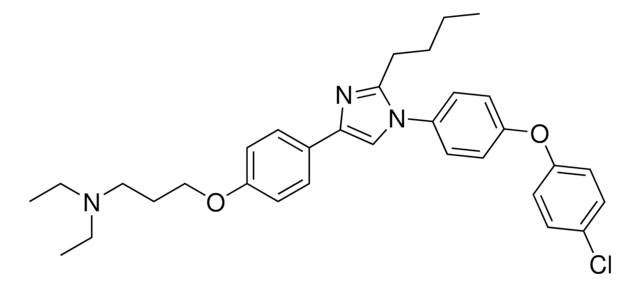E8780
Epiregulin from mouse
recombinant, expressed in E. coli, lyophilized powder, suitable for cell culture
Sinônimo(s):
EREG
Faça loginpara ver os preços organizacionais e de contrato
About This Item
Número MDL:
Código UNSPSC:
12352200
Produtos recomendados
recombinante
expressed in E. coli
Ensaio
≥97% (SDS-PAGE)
forma
lyophilized powder
peso molecular
predicted mol wt ~5.5 kDa
técnica(s)
cell culture | mammalian: suitable
Impurezas
endotoxin, tested
nº de adesão UniProt
temperatura de armazenamento
−20°C
Informações sobre genes
mouse ... Ereg(13874)
Ações bioquímicas/fisiológicas
Binds and activates the tyrosine kinase ErbB family receptors (ErbB1-ErbB4). Inhibits the growth of several epithelial tumor cells and stimulates the growth of fibroblasts and other cell types. Its expression is upregulated in a number of carcinoma cell lines.
forma física
Lyophilized from a 0.2 μm filtered solution in phosphate buffered saline containing 0.5 mg bovine serum albumin.
Nota de preparo
Recombinant Mouse Epiregulin is produced from a DNA sequence encoding the mature mouse epiregulin protein sequence. The protein is expressed in E. coli.
Epiregulin is a member of EGF (epidermal growth factor) family. All members of the EGF family are synthesized as transmembrane precursors and converted to soluble forms by proteolytic cleavage. Epiregulin was originally purified from the mouse fibroblast-derived tumor cell line NIH3T3/T7. Mouse epiregulin cDNA encodes a transmembrane precursorof 162 amino acids with a mature soluble form consisting of residues 56-101. Epiregulin acts like other EGF family members by binding to and activating the tyrosine kinase ErbB family receptors (ErbB1-ErbB4). Epiregulin has a broad specificity, but this ligand seems to preferentially activate heterodimeric receptor complexes. Epiregulin inhibits the growth of several epithelial tumor cells and stimulates the growth of fibroblasts and other types of cells. Its expression is upregulated in a number of carcinoma cell lines. Epiregulin is also an autocrine growth factor in human epidermal keratinocytes, and involved in the early stages of pregnancy, regulating the attachment of the blastocyst to the uterine epithelium during the implantation process.
Epiregulin is a member of EGF (epidermal growth factor) family. All members of the EGF family are synthesized as transmembrane precursors and converted to soluble forms by proteolytic cleavage. Epiregulin was originally purified from the mouse fibroblast-derived tumor cell line NIH3T3/T7. Mouse epiregulin cDNA encodes a transmembrane precursorof 162 amino acids with a mature soluble form consisting of residues 56-101. Epiregulin acts like other EGF family members by binding to and activating the tyrosine kinase ErbB family receptors (ErbB1-ErbB4). Epiregulin has a broad specificity, but this ligand seems to preferentially activate heterodimeric receptor complexes. Epiregulin inhibits the growth of several epithelial tumor cells and stimulates the growth of fibroblasts and other types of cells. Its expression is upregulated in a number of carcinoma cell lines. Epiregulin is also an autocrine growth factor in human epidermal keratinocytes, and involved in the early stages of pregnancy, regulating the attachment of the blastocyst to the uterine epithelium during the implantation process.
Nota de análise
The biological activity is measured by its ability to stimulate the 3H-thymidine incorporation in a mouse fibroblast cell line, Balb/3T3.
Código de classe de armazenamento
11 - Combustible Solids
Classe de risco de água (WGK)
WGK 3
Ponto de fulgor (°F)
Not applicable
Ponto de fulgor (°C)
Not applicable
Equipamento de proteção individual
Eyeshields, Gloves, type N95 (US)
Certificados de análise (COA)
Busque Certificados de análise (COA) digitando o Número do Lote do produto. Os números de lote e remessa podem ser encontrados no rótulo de um produto após a palavra “Lot” ou “Batch”.
Já possui este produto?
Encontre a documentação dos produtos que você adquiriu recentemente na biblioteca de documentos.
K Hashimoto
Journal of dermatological science, 24 Suppl 1, S46-S50 (2001-01-04)
Various kinds of growth factors are involved in the regulation of human keratinocyte function. Among them, the epidermal growth factor (EGF) family and the transforming growth factor-beta (TGF-beta) family play central roles, providing dual-mode regulation of keratinocyte growth through the
H Toyoda et al.
FEBS letters, 377(3), 403-407 (1995-12-27)
A cDNA clone encoding a novel epidermal growth factor (EGF)-related growth regulator, epiregulin, was isolated from a cDNA library prepared from a mouse fibroblast-derived tumor cell line, NIH3T3/clone T7. The predicted amino acid sequence revealed that the purified epiregulin peptide
Jian-Bo Fan et al.
Molecular and cellular biochemistry, 398(1-2), 105-113 (2014-09-17)
Epidermal growth factor (EGF) receptor (EGFR) emerges as an essential molecule for the regulating of osteoblast cellular functions. In the current study, we explored the effect of epiregulin, a new EGFR ligand, on osteoblast functions in vitro, and studied the
K P Karey et al.
Cancer research, 48(14), 4083-4092 (1988-07-15)
A completely serum-free assay method has been used to compare the mitogenic activities of polypeptide growth factors and estrogens with MCF-7 and T47D human breast cancer cells in culture. The lines were maintained in a viable, slowly dividing condition in
Teresa Elo et al.
Endocrine-related cancer, 21(4), 677-690 (2014-06-19)
Estrogens contribute to the development and growth of the prostate and are implicated in prostate tumorigenesis. In their target tissues, estrogens mediate their effects via estrogen receptor α (ERα (ESR1)) and β (ERβ (ESR2)). Hyperplasia and decreased differentiation of epithelial
Nossa equipe de cientistas tem experiência em todas as áreas de pesquisa, incluindo Life Sciences, ciência de materiais, síntese química, cromatografia, química analítica e muitas outras.
Entre em contato com a assistência técnica





